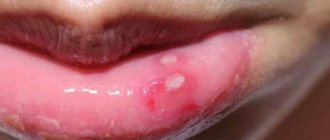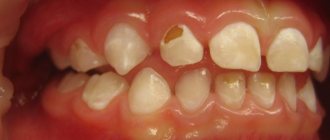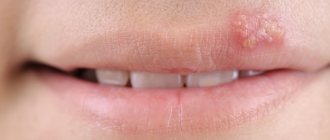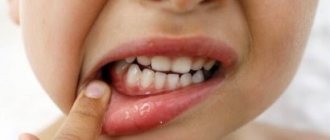Causes of white spots on the lips of a newborn baby
The appearance of white spots on the lips of an infant may be due to:
- candidal stomatitis (thrush) - due to the activation of the opportunistic yeast-like fungus Candida. This is the most common cause of the appearance of white spots on the lips of children in the first year of life;
- bacterial stomatitis - an attack of microbes, usually strepto- or staphylococci, on the oral mucosa weakened by the provoking factor;
- herpetic infection - herpes simplex virus type I, activated against the background of a decrease in local or general immunity;
- allergic stomatitis - when the oral mucosa is exposed to substances to which the child has an abnormally high sensitivity.
Factors that create a favorable environment for the introduction of the pathogen and the development of the disease include:
- low immune defense;
- prematurity;
- artificial feeding;
- insufficient hygiene of the infant's oral cavity, maternal nipple, bottles, pacifiers, nipples;
- microtrauma of the mucous membrane - thermal, mechanical or chemical - in which an entrance gate for infection is formed;
- nutritional imbalance - lack of breast milk or a mixture of vitamins, macro- and microelements;
- difficulty passing air through the nasal passages - breathing through the mouth dries out the mucous membrane, increasing the risk of microtraumas and infections;
- pathologies of the digestive and endocrine systems - diabetes, hepatitis, dysbacteriosis.
For stomatitis to occur, a combination of two conditions is necessary: activation of the pathogen and predisposition of the mucous membrane to the disease due to the influence of the provoking factor.
Associated symptoms
The appearance of white spots on the lips may be accompanied by associated symptoms.
- The appearance of vesicles in herpes may be preceded by a sensation of itching, burning, tingling at the site of the virus attack.
- Aphthae (erosions) formed during bacterial or fungal stomatitis are very painful, especially when sucking, irritation with milk or food.
- Massive lesions of the mucous membrane by any type of pathogen can be accompanied by lethargy, refusal to eat, crying, and drooling.
In the absence of treatment or the addition of a secondary infection, the aphthae can undergo necrosis, to which the baby’s body reacts with symptoms of general intoxication: a rise in temperature to 39-40 ° C, anxiety, fever, and an unpleasant odor from the baby’s mouth.
Immunity-weakening diseases - the root causes of white spots on a child’s lips are manifested by organ or systemic symptoms: dyspeptic disorders, pain, bloating, frequent regurgitation, etc.
Streptoderma in children
Streptococcal impetigo in children
The favorite localization of inflammation in children is the skin of the face, hands and other open areas of the skin.
The disease begins with the appearance on a hyperemic background or externally unchanged skin of the primary morphological element of streptoderma - phlyctena with a diameter of 1 to 2-3 mm, surrounded by an inflammatory rim. At first, phlyctena is a tense vesicle, which soon becomes flabby, and its contents turn from light serous to cloudy or purulent. Subsequently, the conflicts dry out into honey-yellow crusts, after peeling off which a pink spot remains. Individual conflicts can be isolated from each other by areas of healthy skin or increase in size due to growth along the periphery and merge. The development of the elements is accompanied by severe itching, which is why children scratch the skin, spreading the infection to healthy areas where new conflicts form. The duration of streptoderma in children is 3-4 weeks.
Slit-like impetigo in children
This form of streptoderma in children is also called seizure or angular stomatitis. Phlyctens are usually localized in the corners of the mouth, less often - at the wings of the nose or in the corners of the eyes. In place of the opened blisters, shallow cracks, covered with yellowish crusts, form.
This type of streptoderma in children occurs with itching in the mouth, drooling, burning, and pain when eating. The protracted course of slit-like impetigo is promoted by caries, rhinitis, conjunctivitis, and the habit of licking lips. The infection is easily transmitted through kissing and sharing utensils, so familial cases of the disease are common.
Lichen simplex in children
This form of streptoderma in children belongs to the dry variety of streptococcal impetigo, i.e. it occurs without the formation of conflicts. The infection affects the face (perioral area, cheeks, chin), and less commonly, the skin of the trunk and limbs.
In this case, in the lesions, delimited lesions of a round or oval shape, white-pink in color, covered with small dry scales are formed. After exposure to the sun, the elements decrease or disappear completely, but the affected areas of the skin are less pigmented, which is why the skin takes on a mottled appearance.
Dry streptoderma in children usually occurs in the fall or spring, often in the form of epidemic outbreaks in children's groups.
Streptococcal diaper rash in children
With intertriginous streptoderma in children, inflammatory elements are located in the folds of the abdomen, inguinal-femoral, intergluteal, axillary region, and behind the ears. Primary elements - conflicts - merge into wet, eroded surfaces. The lesions have a bright pink color, scalloped borders and a rim along the periphery. Around the main focus there are screenings in the form of individual elements at different stages of evolution (vesicles, pustules, crusts).
Painful cracks and erosions often form in the skin folds, dramatically affecting the child’s well-being. This clinical variant of streptoderma in children is prone to chronicity and is often aggravated by the addition of a secondary fungal infection.
Vulgar ecthyma in children
Vulgar ecthyma in children refers to deep streptoderma of the skin. In most cases, it develops in weakened and often ill children, with poor hygienic skin care, and itchy dermatoses. Elements of streptoderma are localized on the legs, thighs, buttocks, lower back, and less commonly, the upper limbs and torso.
Initially, a phlyctena or pustule with serous-bloody or serous-purulent contents forms at the site of infection, which quickly dries into a soft yellowish-brown crust. When the crust is removed, a deep, painful ulcer is exposed, the bottom of which is covered with a dirty gray coating. After 2–4 weeks, a pigmented scar forms at the site of the ulcer.
Severe forms of ulcerative streptoderma in children include perforating and necrotic (gangrenous) ecthyma: in these cases, ulcers can penetrate deep into the dermis and subcutaneous fat.
The forms of streptoderma discussed above in children are often accompanied by a disturbance in the general condition, fever, and regional lymphadenitis.
Diagnostic methods
Upon examination, a specialist can determine that the child has stomatitis. However, identifying the root cause of its occurrence and the type of damaging factor can be difficult for him.
For this purpose, additional examination is carried out:
- blood for polymerase chain reaction - to determine the nature of the pathogen, allows you to confirm herpes;
- scraping from the aft - to identify the pathogen (streptococcus, staphylococcus, etc.), its susceptibility to antibiotic therapy;
- performing allergy tests, blood testing for immunocomplexes, conducting an immunogram - to study the body’s response to allergens.
According to indications, a hardware ultrasound examination, consultation with a pediatrician, and specialists are prescribed.
Methods of treating diathesis
When dealing with diathesis in a young child, the main thing is to choose the right diet, excluding foods that may cause an allergic reaction.
For a child in his first year of life, it is very important to receive breast milk.
The proteins of human milk are easily broken down by the baby's enzymes and are completely devoid of allergic properties. However, a nursing mother must also follow a diet excluding fish, poultry, tomatoes, chocolate, smoked meats, spices and other allergenic foods.
When mixed feeding, the child should not be given some juices: orange, carrot, tomato. Introduce any new product carefully - from a small amount. It is important to prevent an allergic exacerbation, and at the same time, to give the baby’s body everything it needs for its development.
Specialist consultation
The Family Doctor pediatric allergist-immunologist will help you deal with your child’s skin problems, determine the cause of allergies, and also build a rational diet that is suitable specifically for your child.
Make an appointment Do not self-medicate. Contact our specialists who will correctly diagnose and prescribe treatment.
Rate how useful the material was
thank you for rating
How to treat white spots on the lips of a baby?
According to experts, the use of traditional medicine methods is not the best option to combat the problem. In order not to harm the child, it is not recommended to perform certain manipulations.
- Treat with a finger wrapped in gauze - this can further damage the delicate mucous membrane of the child’s lips and aggravate the problem. Use cotton swabs or pieces of sterile cotton wool.
- To treat aphthae, use a solution of brilliant green, tincture of iodine, or fucorcin - there is a high probability of causing a chemical burn.
- Use infusions of medicinal herbs - when treating or irrigating the mucous membrane, some of the solutions will inevitably be swallowed by the child, which can negatively affect digestion.
- Apply honey to the aphthae. Firstly, there is a high risk of the baby developing an allergic reaction. Secondly, sweets, being an excellent breeding ground for bacteria and fungi, stimulate their growth and development.
The basic principles of treating white spots in a child are maintaining good oral hygiene, gentle nutrition, and using medications as recommended by a pediatrician according to the child’s age.
- After each feeding, the oral cavity is washed using an irrigation bottle or bulb. To do this, the child is placed on his side, and the remaining milk or formula is removed with a gentle pressure of water.
- Then the top layer of plaque is removed from the spots and treated with a product prescribed by the pediatrician, taking into account the type of pathogen.
Local medications that are used to treat children for white spots include several groups aimed at combating a specific problem.
- If thrush is confirmed, pediatricians may prescribe to a newborn: Candida solution to treat white spots on the lips;
- Such babies are often advised to treat with a 2% aqueous solution of baking soda.
- Six-month-old children and older may additionally be prescribed Miramistin, Fluconazole, Diflucan.
- babies over one year old are treated with Lugol, Nystatin.
- Kamistad Baby, Kalgel - antiseptics containing painkillers;
- for children in the first year of life - Viferon gel, oxolinic ointment;
With widespread or severe stomatitis, local treatment alone may not be enough, and the pediatrician decides to additionally prescribe the drug for internal use.
- Antiviral, antibacterial, antifungal - depending on the type of pathogen.
- Allergic stomatitis requires antihistamines for newborns: Suprastin, Tavegil.
- Febrile fever is relieved with antipyretics, approved for use in children of the first year of life in the form of rectal suppositories, suspensions: Daleron, Ibuprofen, Nurofen, Calpol, etc.
- The vitamin and mineral balance of the body is replenished with age-appropriate treatment and prophylactic complexes.
Strictly adhere to the age-related dosages recommended by the doctor: the use of medications intended for older children can be harmful, and medications intended for younger children will not have the desired effect.
Causes of thrush in a child
Because the child’s immunity is still too weak and this contributes to the development of favorable conditions for the development of candidiasis (candida fungi are the first of the microscopic fungi that a child encounters at birth).
In the first week of life, so-called thrush (damage to the mucous membranes of the oral cavity) may develop in the form of a cheesy white coating on the inner surface of the neck, tongue and gums. Basically, this process is temporary and goes away during the first month of life, and with a weakened immune system, thrush can be recurrent and difficult to treat. In addition, if the skin is damaged, the process can spread to natural folds and in the area of diaper rash. Healthy skin can resist the effects of fungi on its own, but damaged skin cannot do this, and a fungal infection can become more severe. Breastfeeding plays an important role because breast milk helps repopulate the sterile intestines with beneficial microorganisms. Therefore, the body of bottle-fed children is more susceptible to infection entering the body.
The process of fungal development is aggravated by wearing diapers, which create a “greenhouse effect” and due to the warm, humid environment, fungal infections multiply quickly. A healthy breastfed baby cannot develop candidiasis. If thrush appears again after treatment, this should be assessed as a signal that the immune system is weakened. In children, candidiasis can either be temporary or become a serious disease requiring treatment from a specialist.
Recurring oral thrush in infants can cause damage to the fingernails. This occurs in infants who prefer their finger to the pacifier. As a result of the lesion, the nail plate becomes deformed, thickens, the periungual fold turns red and a white mass is released from under it.
In girls, candidiasis can develop into candidal vulvitis, and in boys, balanoposthitis can occur (redness and a white cheesy coating appear in the area of the urethral opening). These phenomena may not bother the child, but are sometimes accompanied by itching, burning and pain.
In older children, Candida fungi can cause allergic diseases, which, in turn, affect the skin, mucous membranes and intestines. Therefore, children with allergic diseases should undergo a comprehensive examination, including for possible candidiasis.
Prevention measures
To prevent the development of fungal, bacterial or viral stomatitis, follow the recommendations:
- comply with hygiene requirements - wash hands, toys, boil bottles and nipples, pacifiers;
- treat the mother's nipple with a soda solution before feeding - targeted prevention of thrush;
- limit sweets;
- support intestinal microflora, preventing the development of dysbiosis;
- do not give crackers to prevent damage to the mucous membrane;
- use soft toothbrushes and pastes containing lysozyme and lactoferrin - enzymes that help increase local immunity of the oral cavity;
- activate the immune defense of the child’s body - harden it, conduct preventive courses of vitamin preparations.
If white spots appear on the child’s lips, contact a specialist.











